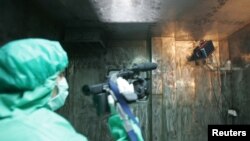Government-run surveillance cameras around Iran's capital reportedly were disrupted Thursday, and an exile group claimed it hacked into more than 5,000 cameras around Tehran ahead of the commemoration of the death of the founder of the Islamic Republic.
The Young Journalists Club, an affiliate of Iranian state television, acknowledged the disruption on Twitter after the Mujahedeen-e-Khalq (MEK) claimed it penetrated the cameras, including those around the V The website for Tehran's municipality also went down, as well as communication systems used by the city, the report said.
The semiofficial ISNA news agency later quoted Tehran's municipality as acknowledging the hack.
The Mujahedeen-e-Khalq released a video clip it claimed showed the municipality website and others defaced with a graphic that criticized the "anti-human Khomeini." It also included an image of Supreme Leader Ayatollah Ali Khamenei with a red "X" over his face, as well as images of MEK leaders Massoud Rajavi and his wife, Maryam Rajavi, while calling for an "uprising until overthrow."
"Down with Khamenei, Raisi, curses on Khomeini," the graphic read.
Massoud Rajavi hasn't been seen publicly in nearly two decades and is presumed to have died. Maryam Rajavi now runs MEK. Khomeini, who led Iran's 1979 Islamic Revolution, died June 3, 1989.
The hack comes after another cyberattack in January that saw the Rajavis and a graphic calling for the death of the country's supreme leader played on multiple state TV channels.
In October, an assault on Iran's fuel distribution system paralyzed gas stations nationwide, leading to long lines of angry motorists unable to get subsidized fuel for days. A cyberattack on Iran's railway system caused chaos and train delays. Another hack leaked footage of abuses at its notorious Evin prison.
Iran, long sanctioned by the West, faces difficulties in getting up-to-date hardware and software, often relying on Chinese-manufactured electronics or older systems. Pirated versions of Windows and other software are common across Iran. That makes it easier for potential hackers to target the country.
MEK began as a Marxist group opposing the rule of Shah Mohammad Reza Pahlavi. It claimed and was suspected in a series of attacks against U.S. officials in Iran in the 1970s, something the group now denies.
It supported the 1979 Islamic Revolution, but soon had a falling out with Khomeini and turned against the cleric. It carried out a series of assassinations and bombings targeting the young Islamic Republic.
MEK members later fled into Iraq and backed dictator Saddam Hussein during his bloody eight-year war against Iran in the 1980s. That saw many oppose the group in Iran. Although largely based in Albania, to this day the group claims to operate a network inside Iran.








